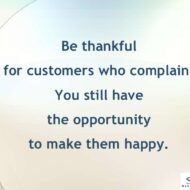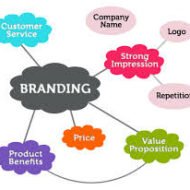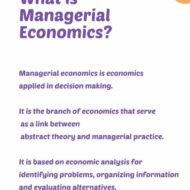Posted by Managementguru in Business Management, How To, Marketing, Sales
on Dec 2nd, 2015 | 0 comments

Customer Service is the emerging battlefield where small businesses need to score. And if they manage to do well here, then their brands can get automatically differentiated. “Customers may forget what you said but they’ll never forget how you made them feel. “ The existing customers can function as the brand advocates, socially endorsing the business on all channels. Customers today demand to engage with both small and big brands on a 1-to-1 basis. They expect the brands to remember their names and details on second interaction onwards. CRM – The Importance of Customer Relationship Management The depicted infographic here clearly chalks out what needs to be done when it comes to resolving customer issues by delivering a smooth and seamless experience through various channels. Customer Relationship Management is the central point of this infographic developed in tandem with TalkDesk covering the importance of Customer Service across all communication channels, and how to make sure every customer is treated like a VIP. Infographic Courtesy : Kaylee White Ghergich & Co. Social Media and User Experience Social Media has its own role to play when it comes to “USER EXPERIENCE”- Convince and Convert suggests that 42% of customers develop two minds about a brand if they do not get a social reply from it within 1 hour. So it becomes essential for all businesses to have the capability to get back to the customers promptly on social media. Customers want effortless engagement Successful companies recognize that the race from good to great customer experiences is on and that consumers just want effortless engagement. Client service teams must now use data from social media platforms, mobile apps, loyalty programs and a host of other sources to tailor experiences to their customers. The goal is to gain a competitive edge and that means creating an emotional, therefore memorable experience for your customers. Poor client service has an impact on the bottom line and profit margins. Good customer service can be the greatest sales asset a retailer can have, encouraging loyalty and word-of-mouth recommendations. But bad customer service cannot only see a particular sale lost in an instant, but long-term irreparable damage done to the brand. Secure Your Place in the Market Through Great Customer Service Firstly, marketplaces are competitive. There are numerous sellers, sometimes selling fairly similar products. One point of differentiation is price, but another is certainly customer service. There is great cache to being listed as one of the number one sellers on a marketplace. Customers see you first, and you rank highly in searches. One of the ways to reach this status is via customer service, so sellers really go the extra mile to ensure customer service is as good as it possibly can...

Posted by Managementguru in Business Management, Marketing, Principles of Management
on Mar 4th, 2014 | 0 comments

Trends in Consumer Marketing FMCG’s: Consumer marketing is defined as creating and selling products, goods and services to individual buyers, as opposed to trying to appeal to businesses. You would have often heard about this – Fast moving consumer goods. These are nothing but products that are destined for use by ultimate customers or households that cannot be done with, as their usage is on a day to day basis. It might make some sense if I cite some examples – toothpaste, soaps, shaving creams, talcs, body lotions; these are meant for personal consumption and the demand for such products is direct and needs less of relationship marketing. Brand Focus: The number of customers in the consumer market is relatively large and the product purchase is influenced by even emotional factors. The focus is on the brand name and some people ardently follow a particular brand for ages, and this might be attributed to the effect that has been created by mass media advertising, or it might be due to the fact that they might identify themselves in some or the other with the product. It becomes a personal companion over a period of time. Impulse Buying: The decision making process is informal and often simple. Sometimes, it is influenced by the budget equations and feasibility. Impulse buying is also common in consumer market. At times, the consumers go adventurous and like to try their hands on new products. Branding is an important feature that retains the customer base for business firms and that’s why market analysts are attaching so much of significance to advertisements and sales promotions, to make their product a household name. Distribution Network: The firms must have a pucca distribution network linking different parts of the territories, where they want to expand their market. Say, for instance, a soft drink can be made popular by branding, but if there is no sufficient supply in the market, how do you expect customers to support your product? Equally important is providing the customers with a product size that best suits their budget. Consumer Marketing Infographic: Researchomatic.com Market Segmentation: Market segmentation recognizes the existence of distinct market groups, each with a distinct set of needs. Through segmentation, the firm directs its product and promotional efforts towards those markets that will benefit most from or will get the greatest enjoyment from its merchandise. Over the years, segmentation has become a popular strategic technique as the market is ever flushed with competitors. Influence of Price: A number of sellers are seen in this kind of consumer market and it is only the market that decides the price and not the participants. The marketers have nothing to lose if they sell at the market price, but if they plan to sell at slightly higher price levels than that of the market, it will prove detrimental to their objective. https://www.businessmodelscholar.com/wp-content/uploads/2020/06/3.pdf They are only price takers and not price makers. But they have the leverage to freely enter and exit the market. If the consumers foresee a fall in the general price levels of a product, they wait for some more time to take full advantage of the situation and decide to postpone the purchase. If the market shows an increasing price trend, it is the other way round, either they buy in bulk or go for substitutes.Say, if the price levels of coffee is on the rise, people opt for tea. Demand for consumer goods is price elastic. Consumers don’t care for much technical specifications; they only care for the quality backed up by a strong brand name. Post by Free MBA...

Posted by Managementguru in Business Management, Economics, International Business, Principles of Management
on Feb 16th, 2014 | 0 comments

The factors that affect the economic environment of business are listed below. Macro Environment The management of a firm is influenced and affected by many factors that exist in the external environment, also called as macro environment. These are beyond the scope of business control and affect the functioning of a business enterprise. Factors of External Environment that Affect Business These factors may present themselves in the form of opportunities or threats and it is the responsibility of a manager to identify the changes in the external environment, be it, social, economic, political, legal, technological, demographic or ecological and devise action plans accordingly, to suit the changing demands and needs of the macro environment. Buying Power of People The most important and prime factor that affects a firm’s operations and its basic survival is the economic factor. Economy of a country is prosperous only when it is self sufficient and withstands the pressure of inflation or recession. Businesses can flourish only if there is a regular demand for the products manufactured. Economic Factors that Affect Demand The buying power of people and their willingness to pay are also important economic factors that affect demand. In developing countries, people concentrate on “saving” rather than spending, where the economy is showing steady growth. For instance in India, people invest their money in gold and land,both being considered as solid appreciating disposable income,assets. Why do we turn to nonprofits, NGOs and governments to solve society’s biggest problems? Michael Porter admits he’s biased, as a business school professor, but he wants you to hear his case for letting business try to solve massive problems like climate change and access to water. Why? Because when business solves a problem, it makes a profit — which lets that solution grow. Watch the Video Disposable Income The ability of people to buy, largely depends on their employment, income tax and price of the product. The disposable income of people in developing countries is very meager and it further decreases if the rate of tax increases. Ability to Buy This also affects his or her ability to buy. If his concentration is on “saving”, again his ability to purchase is restricted. Even if the individual has the purchasing power, there is no assurance that he or she will buy, it all depends on their willingness to buy. The purchasing power parity of developing countries is very low when compared to developed countries. Role of Technology In recent times, technology also has played an enormous role in bringing an array of new products into the market, and has improved man’s preference for better products. For a business firm, it is very difficult to predict people’s preference as well as changes in their preferences. It needs a great deal of market research and regular updations. If the prices are in decreasing trend, people will not buy the product immediately; they will wait for some more time to derive maximum benefit or value out of their purchase. So, people’s perception about the market economy, social influences and changing preferences definitely affect the willingness to buy. Competitive Market Managing the competition proves to be a tougher task for each and every individual business firm. In today’s modern high flying business environment, people always expect value added services for the products purchased. Business organisations are in a position to compete for customer’s interest as well as income. Firms think of price reductions, aggressive promotional efforts, attractive offers, differentiated product offerings and customer service as competitive tools to have a sustainable and distinctive advantage over others. Offering new product designs, attractive packing, extended credit facilities, free door delivery and fast and competent repair services...

Posted by Managementguru in Economics, Financial Management
on Feb 14th, 2014 | 0 comments

Introduction to the basic concepts of managerial economics and how it helps in managerial decision making. Managerial economics is concerned with various micro and macro-economic tools and analysis which can be used in managerial decision making to solve business problems.








